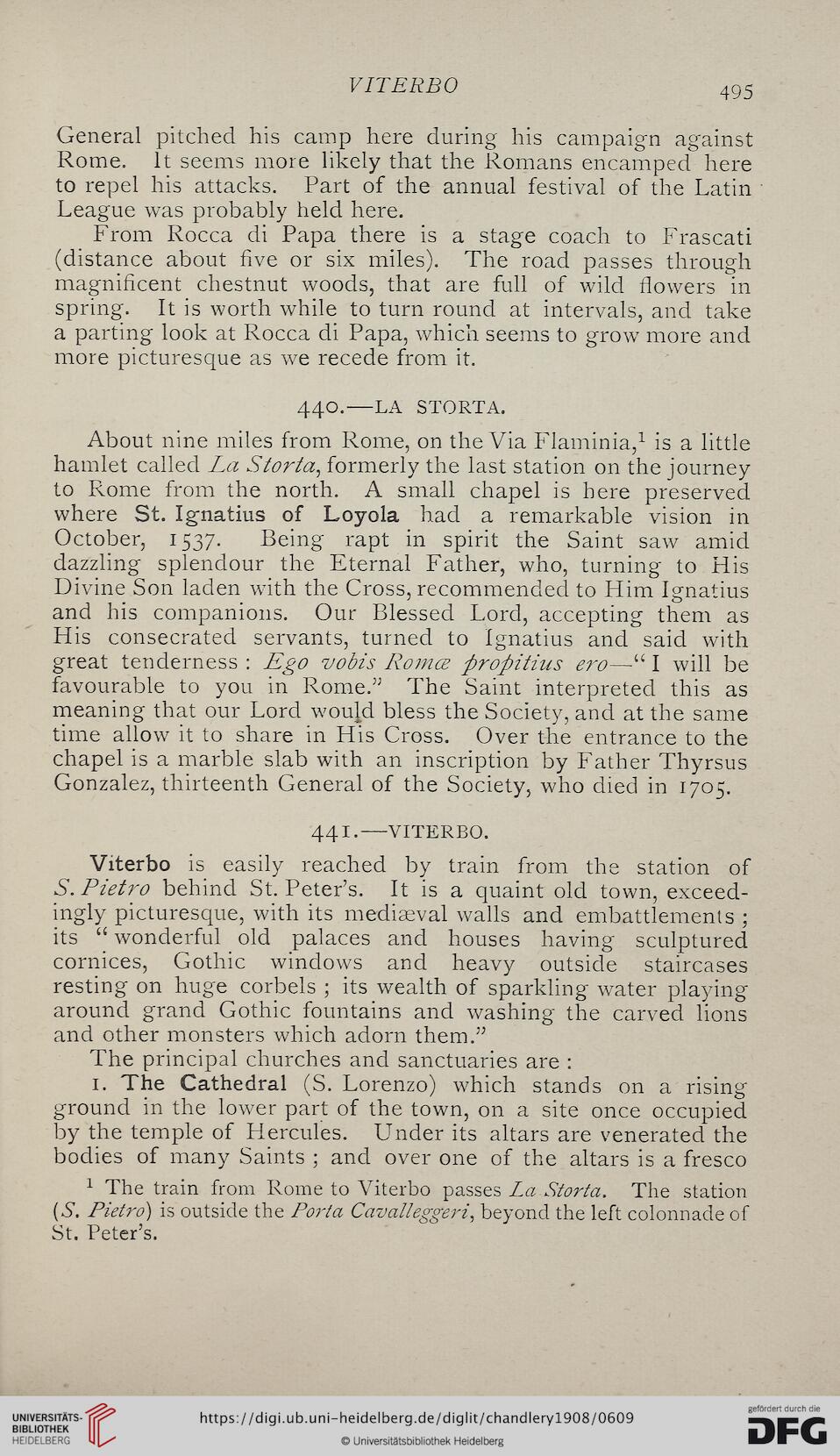VITERBO
495
General pitched his camp here during his campaign against
Rome. It seems more likely that the Romans encamped here
to repel his attacks. Part of the annual festival of the Latin
League was probably held here.
From Rocca di Papa there is a stage coach to Frascati
(distance about five or six miles). The road passes through
magnificent chestnut woods, that are full of wild flowers in
spring. It is worth while to turn round at intervals, and take
a parting look at Rocca di Papa, which seems to grow more and
more picturesque as we recede from it.
440.—LA STORTA.
About nine miles from Rome, on the Via Flaminia,1 is a little
hamlet called La Storla, formerly the last station on the journey
to Rome from the north. A small chapel is here preserved
where St. Ignatius of Loyola had a remarkable vision in
October, 1537. Being rapt in spirit the Saint saw amid
dazzling splendour the Eternal Father, who, turning to His
Divine Son laden with the Cross, recommended to Him Ignatius
and his companions. Our Blessed Lord, accepting them as
His consecrated servants, turned to Ignatius and said with
great tenderness : Ego vobis Roma propitius ero—“ I will be
favourable to you in Rome.” The Saint interpreted this as
meaning that our Lord would bless the Society, and at the same
time allow it to share in His Cross. Over the entrance to the
chapel is a marble slab with an inscription by Father Thyrsus
Gonzalez, thirteenth General of the Society, who died in 1705.
441.-VITERBO.
Viterbo is easily reached by train from the station of
5. Pietro behind St. Peter’s. It is a quaint old town, exceed-
ingly picturesque, with its mediaeval walls and embattlements ;
its “ wonderful old palaces and houses having sculptured
cornices, Gothic windows and heavy outside staircases
resting on huge corbels ; its wealth of sparkling water playing
around grand Gothic fountains and washing the carved lions
and other monsters which adorn them.”
The principal churches and sanctuaries are :
1. The Cathedral (S. Lorenzo) which stands on a rising
ground in the lower part of the town, on a site once occupied
by the temple of Hercules. Under its altars are venerated the
bodies of many Saints ; and over one of the altars is a fresco
1 The train from Rome to Viterbo passes La Storta. The station
(5. Pietro} is outside the Porta Cavalleggeri, beyond the left colonnade of
St. Peter’s.
495
General pitched his camp here during his campaign against
Rome. It seems more likely that the Romans encamped here
to repel his attacks. Part of the annual festival of the Latin
League was probably held here.
From Rocca di Papa there is a stage coach to Frascati
(distance about five or six miles). The road passes through
magnificent chestnut woods, that are full of wild flowers in
spring. It is worth while to turn round at intervals, and take
a parting look at Rocca di Papa, which seems to grow more and
more picturesque as we recede from it.
440.—LA STORTA.
About nine miles from Rome, on the Via Flaminia,1 is a little
hamlet called La Storla, formerly the last station on the journey
to Rome from the north. A small chapel is here preserved
where St. Ignatius of Loyola had a remarkable vision in
October, 1537. Being rapt in spirit the Saint saw amid
dazzling splendour the Eternal Father, who, turning to His
Divine Son laden with the Cross, recommended to Him Ignatius
and his companions. Our Blessed Lord, accepting them as
His consecrated servants, turned to Ignatius and said with
great tenderness : Ego vobis Roma propitius ero—“ I will be
favourable to you in Rome.” The Saint interpreted this as
meaning that our Lord would bless the Society, and at the same
time allow it to share in His Cross. Over the entrance to the
chapel is a marble slab with an inscription by Father Thyrsus
Gonzalez, thirteenth General of the Society, who died in 1705.
441.-VITERBO.
Viterbo is easily reached by train from the station of
5. Pietro behind St. Peter’s. It is a quaint old town, exceed-
ingly picturesque, with its mediaeval walls and embattlements ;
its “ wonderful old palaces and houses having sculptured
cornices, Gothic windows and heavy outside staircases
resting on huge corbels ; its wealth of sparkling water playing
around grand Gothic fountains and washing the carved lions
and other monsters which adorn them.”
The principal churches and sanctuaries are :
1. The Cathedral (S. Lorenzo) which stands on a rising
ground in the lower part of the town, on a site once occupied
by the temple of Hercules. Under its altars are venerated the
bodies of many Saints ; and over one of the altars is a fresco
1 The train from Rome to Viterbo passes La Storta. The station
(5. Pietro} is outside the Porta Cavalleggeri, beyond the left colonnade of
St. Peter’s.




